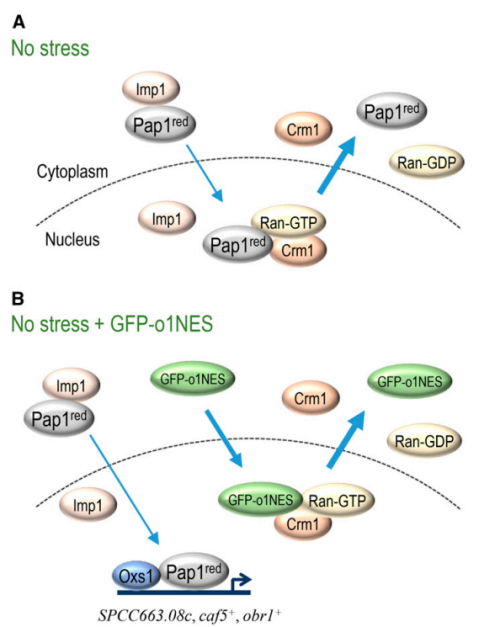Protection from disulfide stress by inhibition of Pap1 nuclear export in fission yeast
Previous work from Dr. David W. Ow’s lab elucidated a new Pap1-Oxs1 pathway specific for the diamide-induced disulfide stress response in the fission yeast Schizosaccharomyces pombe, which appears to be evolutionarily conserved (He et al. 2017. Nucleic Acids Res. 45: 106–114). In current study, PhD student Yan Chen and colleagues found that overproduction of a peptide conjugate containing Oxs1 NES (nuclear export signal) protects fission yeast against disulfide stress by serving as a competitive substrate for Crm1-mediated nuclear export of Pap1 (Figure 1). The higher concentration of Pap1 in the nucleus upregulates several resistance genes and primes the cells for higher tolerance to disulfide stress.
Overproduction of Crm1 in cancer cells induces excessive nuclear export of a tumor suppressor, p53 (Sionov and Haupt 1999, van der Watt et al. 2009) and the treatment with drugs that inhibits Crm1 function enhances p53 nuclear retention and reduces cancer cell proliferation (Hietanen et al. 2000). In addition, Crm1-mediated nuclear export can be used by many viruses (e.g., HIV-1 and influenza) to export their synthesized products (Nagai-Fukataki et al. 2011; Pickens and Tripp2018), which means that the inhibition of Crm1-mediated nuclear export is promising to be applied in antiviral therapy. Therefore, the protection method of blocking Crm1 mediated export of nuclear proteins unraveled in this study may find medical relevance as an alternative to chemical drugs currently being tested to block the nuclear export of tumor suppressors in cancer therapy, or proteins necessary for maturation of HIV-1 and influenza viruses.

Figure 1 Pap1 nucleocytoplasmic shuttling altered by Crm1 competitive substrate. (A) In the absence of stress, Crm1-mediated Pap1red (reduced form of Pap1) export predominates over Pap1red entry into nucleus. (B) Overproduction of GFP-oxs1 NES competes for Crm1-mediated export, leading to Pap1red accumulation in the nucleus and activation of drug-resistance genes in which Oxs1 can be but not required as a coregulator.
This study was conducted by Dr. Yan Chen (first author) and colleagues under the supervision by Dr. David W. Ow (corresponding author). This work was supported by the Ministry of Science and Technology of China (grant 2016YFD0101904), the National Natural Science Foundation of China (grant 31271701),and the Department of Science and Technology of Guangdong Province (grant 2015B020231009). The relevant paper entitled “Protection from Disulfide Stress by Inhibition of Pap1 Nuclear Export in Schizosaccharomyces pombe” has been published in “Genetics”(2018IF = 4.075). http://www.genetics.org/content/210/3/857.
File Download: